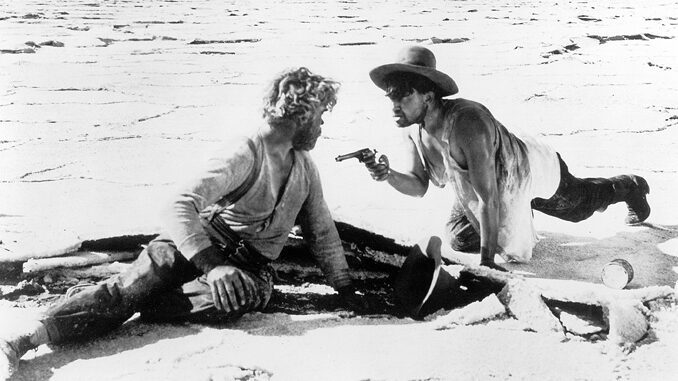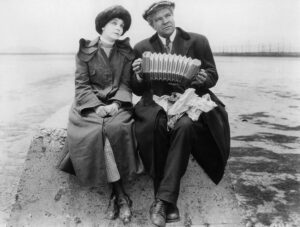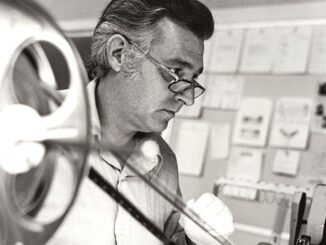
by Edward Landler
An adaptation of Frank Norris’ novel McTeague, published in 1899, Erich von Stroheim’s Greed depicts the life of a physically powerful but mentally dull man who leaves his brutish work in a Sierra Nevada goldmine to become an unlicensed dentist in San Francisco, where he marries the daughter of German immigrants. Together, they descend into brutish poverty. The film was released 90 years ago, in early December 1924 in New York City, in 10 reels — roughly 120 minutes (at 20 fps, the projection speed of most silent films by that year).
The preceding January, Stroheim had presented his first cut of the film, prepared with editor Frank E. Hull from over 85 hours of footage. This version ran 42 reels
— about nine hours. How Stroheim’s attempt to create a trenchant perspective on American society was reduced to its final release length was a major struggle over creative control in the growing studio system. The result of this clash between artistic ambition and the business of making money strengthened the dominance of the front office in Hollywood.
Born in Vienna in 1885, Erich Oswald Stroheim was
the son of a Jewish hat maker. Before coming to the United States in 1909, he served in the Austro-Hungarian army, but not as an officer. By 1914, he had made his way into the movie industry in Los Angeles and had tacked a “von” in front of his surname. This allowed others to speculate that he was gentile, an aristocrat and a former officer in the Imperial army, and he offered no denials.
Stroheim worked as production assistant, technical advisor, assistant director and bit player in many productions, including D.W. Griffith’s The Birth of a Nation (1915) and Intolerance (1916). A conspicuous role as a leering Prussian officer in a World War I movie called For France (1917) led to similar parts in Griffith’s Hearts of the World (1917) and Allen Holubar’s The Heart of Humanity (1918). Stroheim the actor was soon touted as “the man you love to hate” for his characters’ flagrant evil-doing, like throwing a baby out of a window and tearing the buttons from a nurse’s uniform with his teeth.
Universal Studios’ Carl Laemmle then gave him the opportunity to direct his own screenplays. Stroheim took on this role with relish and rose to prominence as a creative filmmaker with a meticulous eye for detail. His three films at Universal — Blind Husbands (1919), The Devil’s Passkey (1920) and Foolish Wives (1922) — all revolved around married American couples in Europe, social innocents
in contrast to the sophistication bred by experience in
a centuries-old culture. The filmmaker gained, too, a reputation for extravagance by building on the Monterey Peninsula a full-scale reproduction of Monte Carlo’s main square for Wives.
Six weeks into production on his next picture for Universal, Merry-Go-Round (1923), studio executive Irving Thalberg replaced Stroheim with Rupert Julian. The director
had gone over budget creating a detailed reconstruction of pre-war Vienna on the studio lot and shooting huge amounts of footage besides. Six weeks after leaving Universal, he bounced back with a three-picture deal with the Goldwyn Company, the first being his adaptation of Norris’ McTeague.

Influenced by French novelist Emile Zola, Norris helped establish naturalism in American literature by describing objectively and graphically the elements of heredity and environment that shaped the character and fate of his novel’s subjects. Stroheim wanted to incorporate this kind of social perspective into movies by filming the entire story as related in the book in its actual locations. In this film, he hoped to observe the very American emphasis on money and making it for its own sake that diminished the humanity of our culture.
Goldwyn allowed the director to manage the details of the production on his own.
He built no sets and rented a building to serve as production offices and as interiors in the same San Francisco neighborhood where the murder that inspired Norris’ novel had occurred. He shot there and all around San Francisco from March through June of 1923. In July and August, the movie’s harrowing climax was filmed in the searing heat of Death Valley, and production wrapped with scenes shot in Placer County, known as “gold country,” in September.
To achieve the realism the film demanded, the sharp and consistently deep-focus photography was shot by Ben
F. Reynolds, who worked on Stroheim’s three Universal pictures, and William H. Daniels. Daniels went on to become one of Hollywood’s most noted cinematographers, lensing
21 films starring Greta Garbo and winning an Oscar for The Naked City (1948), shot mainly on New York City streets.
Seeking naturalistic performances, the director asked his cast to live in the very locations in which they would act. Englishman Gibson Gowland, who was in Blind Husbands, elicits a sympathy that makes McTeague believable, while Zasu Pitts, gradually slipping into grasping pettiness as his bride Trina, creates one of the screen’s great tragic characters. Pitts, with over 200 credits between 1917 and 1963, became one of the most recognizable supporting actors in American screen comedy.
When Goldwyn executives balked at the 42-reel version of the film in early 1924, the director agreed to cut it to a reasonable length for exhibition, and returned to the cutting room with editor Hull. Years later, Stroheim told biographer Peter Noble, “When I arrived at 24 reels I could not, to save my soul, cut another foot.”
He had hoped that this five-hour cut could be released as a two-part film. But, in April, right after he completed that version, the Loew’s Inc. theatre chain bought the Goldwyn Company, merged it with Metro Pictures and Louis B. Mayer Productions, and created Metro-Goldwyn-Mayer. Studio boss Mayer hired Stroheim’s Universal nemesis Thalberg as production chief, and neither of them wanted to release what they considered an overly depressing movie.
Stroheim said, “When I began working on Greed, the slogan of the Goldwyn Company was ‘the author and the play are the thing.’ However, when the Goldwyn Company became…Metro-Goldwyn- Mayer…their new slogan was ‘the producer is the thing.’”
The filmmaker begged his friend Rex Ingram, director of The Four Horsemen of
the Apocalypse (1921), to cut Greed to an acceptable length. Ingram, along with editor Grant Whytock, who had already edited seven pictures for Ingram and two with Stroheim, cut the film to what some claim was 18 reels. But Whytock, in an interview filmed for a 1979 BBC documentary about Stroheim, stated that they got it down to a two-part, 15-reel picture totaling three hours and 15 minutes.
The editor described the first part of the picture as “quite humorous at times,” which would have helped audiences accept the tragedy of the second half. When this version was screened for executives in New York, he said, “It was well-liked by everybody including [Loew’s Nicholas] Schenck.” While European studios were not averse to releasing two-part films in the early 1920s, the leadership at the new MGM was totally opposed to it; they were only interested in trying to recoup the nearly half-million dollars already spent on the production.
Mayer and Thalberg brought in writer June Mathis and editor/title writer Joseph W. Farnham to cut Greed by a full hour, down to 10 reels. A major scenarist of the time, Mathis had adapted The Four Horsemen of the Apocalypse and was then working on the production of Ben Hur (1925). Though the director retained the screen credit stipulated in his original contract — “Personally Directed by Erich von Stroheim” — Mathis’ name preceded Stroheim’s under “Screen Adaptation and Scenario by.”
Farnham was credited as editor, and Hull’s name did not appear at all. Greed was the last of the former’s six editing credits, but he continued to work as a title writer in silents and as a dialogue writer for talkies. One of the 36 founders of the Academy of Motion Picture Arts and Sciences, Farnham received the only Oscar ever given for Title Writing for his body of work (13 films) in 1928, including King Vidor’s The Crowd and Buster Keaton’s The Cameraman.
This was like an exhumation for me. In a tiny coffin, I found a lot of dust, a terrible smell, a couple bits of backbone and a shoulder bone. – Erich von Stoheim
These ultimate editors of Greed — with input from Thalberg — pared the film to a series of major plot points. The material grounding the characters in a fully realized social environment that connected these scenes as a story was brutally excised. The carefully observed “cause-and- effect” processes of McTeague’s entry into dentistry and of the evolution of his and his bride Trina’s life together are only two examples of footage only sometimes replaced by wordy and often clumsy titles to explain obvious gaps of continuity. Gradual transformations of personal habits and attitudes seen over time now appeared crudely sudden.
Whytock said of the MGM cut, “What they released was in my opinion a lot of nothing. It was ruined, absolutely ruined.” None of the excised footage has survived. In 1999, producer Rick Schmidlin created a four-hour “reconstruction” of Stroheim’s original conception. Guided by the 1923 continuity script for the movie, he edited together over 600 production stills with the release version to represent the full story as Stroheim intended. Unfortunately, the stills cannot approximate the original framing and editing.
After Greed, Stroheim completed one more project for MGM, The Merry Widow (1925) — a box office hit for the studio — but his career as a director petered out in 1933. He continued working as an actor in Hollywood and Europe, most notably in Jean Renoir’s La Grande Illusion (1937) and Billy Wilder’s Sunset Boulevard (1950).
In 1950, Henri Langlois of the Cinémathèque Française persuaded Stroheim to watch the release version of his film. At the end of the screening, the director wept and said, “This was like an exhumation for me. In a tiny coffin, I found a lot of dust, a terrible smell, a couple bits of backbone and a shoulder bone.”
All the same, the very fragmentary nature of the released version gave the MGM editors little leeway to cut the individual scenes that now constituted the film. Mostly appearing as originally edited by Stroheim and Hull, these indestructible “bits of bone” still retain the power to evoke visceral emotions and instinctual human drives. Despite their truncated setting, the sharply drawn and relentlessly authentic images of Greed substantiate the film’s reputation as a monumental achievement. To this day, Stroheim’s ability to capture raw psychological realism resonates deeply, stirring us to crave for a look at the tragically irretrievable 15-reel cut.






